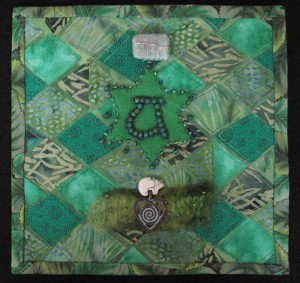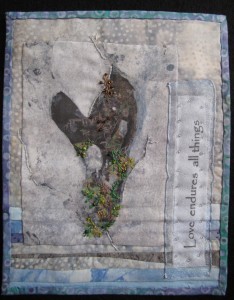I recently read an interesting bit of information which was part of some health study. I don’t remember what the study was really about, but the researchers discovered that people who can turn their attention inward and feel their heartbeat – not using fingers to find their pulse or putting their hand over their heart and feeling the pulse externally, but actually sorting the beat out of the other bodily signals and being able to locate it in their chest by attention alone – tend to be healthier people. [Go ahead, try it…you know you want to. Don’t worry if you can’t find it at first. Keep trying. Closing your eyes usually helps.]
Of course, it isn’t clear whether stronger and/or healthier people simply have a stronger heartbeat that is easier to identify, or whether the self-awareness that leads someone to be able to identify a heartbeat leads that same someone to be more aware of and attentive to other needs expressed by their physical selves: the need for exercise, for nutritious food, for appropriate sleep. And please remember that correlation is not the same as causation (feeling your heartbeat is not going to make you healthy, nor is not feeling it going to make you unhealthy!)
But as I was sitting with my eyes closed and my inner sense tuned to my chest cavity, I began to wonder about the thin line between self-awareness and self-absorption. And I began to wonder about the messages we get from the culture that are so damaging to so many of us – not only adult women and men, but increasingly children as young as eight who try to become the (carefully air-brushed) pictures of the movie stars or sports figures they see.
Some background: I spent much of my early childhood with the Vermont Yankee maternal side of my family, so those stoic values are strongly imprinted…and color my own attitudes quite significantly. My great uncles owned a lumber mill for many years and both of them (at one point or another) cut off a finger in the huge rotating saws. One of them managed to take off two fingers at different times. Short of shutting off the saw long enough to wrap the stump of the finger so it didn’t bleed, they didn’t make any concessions for digital loss (which meant something different before personal computers.)
My grandmother and my great aunts all had arthritis, but they mostly ignored it. (A tablespoon of honey in a juice glass of apple vinegar taken daily was the preventative? remedy? of choice.) Sometimes they would stop for a cup of coffee and I would see them massaging their fingers and palms and wrists, but then it was back to crocheting, knitting, quilting, canning, dressing the deer, plucking chickens, and hanging laundry. Yankees expect to use their bodies up in a lifetime. What would we be saving them for, after all?
And none of them used anything but homeopathic remedies except for the rare times when they actually needed surgery or cancer treatment.
As a result, there was a strong subliminal message in the family: one did not go on and on about aches and pains, or cramps, or twinges, or sliced off fingers. You patched it up, drank your vinegar, and got on with it. No one was really interested in your personal navel-gazing (self-absorption). Self-awareness was a different matter. It was simply assumed that we would all pay attention to staying healthy and flexible and active and alert, because that was how one moved through life with a minimum of fuss and a maximum of productivity.
Cut to the present: Somehow in the intervening half century, something in the culture has shifted in what feels like a very dangerous direction. Being self-aware has become less and less important. An economic system based on consumerism actually benefits from people being un-self-aware. If you are being attentive to real needs and meeting those by wise choices, you are not lusting after something you don’t need, and therefore you are not spending money on treasures that rust or that moths can consume (to paraphrase some spiritual wisdom from the ages.) The less aware we are of the whole (in the sense of holy, complete, essential, integral) self – the less centered we are – the less we understand what is enough (enough material possessions, enough entertainment, enough food, enough experience, enough work). In fact, we are trained (or brain-washed depending on your perspective) to the notion that nothing is enough.
And the odd result is that I am watching more and more people become more and more self-absorbed. Instead of being thoughtfully aware and living out of a belief that we are enough (as opposed to we have enough), we are constantly asking ourselves, How do I feel about this? Is this going to fulfill me? Am I happy? Am I really happy or do I just think I am happy? Does this dress make me look fat? Will this car impress my reunion class? Is my child in advanced pre-K rather than with the ‘normal’ children? Does this wrinkle make me look old? Does my spouse reflect well on me?
Being uncertain of our own worth as a divine image of G-d, we search for worth everywhere else, constantly checking in with some inner emptiness for validation. Which, as you might guess, is not notably fruitful as a pattern of living.
It is a very thin line, and we all wander across it from time to time, but I think it may be imperative that we pull ourselves back across it — definitively and intentionally — sooner rather than later. Among other reasons, our world cannot continue to sustain the wide-spread belief that nothing is enough. And how can we truly love or be loved if we don’t know that we are worthy simply because we are (and, therefore, are enough)? How can we be healthy and active if we are not paying attention to when we are full, and stop eating then rather than 400 calories later? How can we be happy and relaxed (and renewed) if we are so sleep-deprived that our nerves are shot?
I don’t know what the first step is for you (besides pausing each day to notice the miracle of your heartbeat), but I have just thrown away my magnifying mirror which made me yearn for some magic cream that would recreate the skin elasticity of a 40-year old. And I’ve decided to embrace that Yankee conviction that bodies are for using up, so dents and dings are merely the visible manifestations of a full, whole, and holy life.
–Andrea
Text © 2014, Andrea La Sonde Anastos
Photos © 2014, Immram Chara, LLC
NOTE: The two fiber pieces are available in the fiber art section of the website Store.


A very wonderful piece – I will be turning it over in my head all day! …and trying to find my heartbeat, of course.
Thank you for sharing!